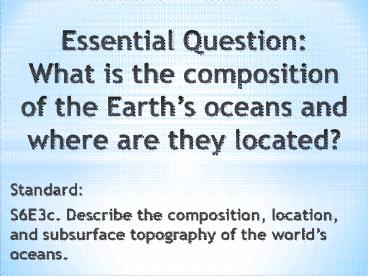Standard: - PowerPoint PPT Presentation
1 / 18
Title: Standard:
1
Essential QuestionWhat is the composition of
the Earths oceans and where are they located?
- Standard
- S6E3c. Describe the composition, location, and
subsurface topography of the worlds oceans.
2
Essential Question What is the composition
of the Earths oceans and where are they
located?
Standard S6E3c. Describe the composition,
location, and subsurface topography of the
worlds oceans.
3
Location of the Earths Oceans
NorthAmerica
Asia
Europe
AtlanticOcean
Lets Start with the Continents
Now the Oceans
PacificOcean
Africa
PacificOcean
SouthAmerica
IndianOcean
Australia
Southern Ocean
Antarctica
4
Location of the Earths Oceans
5
Review Location of the Oceanssee resources
- Use sheet protectors with maps and either do
formative assessment led by the teacher or have
students work with partners to quiz each other - Location of Oceans and Continents Worksheet
- QR Codes Reviewing the Location of the Oceans
- Play Kahoot https//play.kahoot.it//k/783b7b97-4
964-41aa-ab10-2b4a91368d20 free Web 2.0 tool
where students use their cell phone to answer
questions and get points
6
Chemical Composition of Ocean Water
7
What does the word composition mean? What are
some synonyms?
Structure
Make-up
Parts
Pieces
Content
Components
8
With a partner, select one of the following foods
and describe its composition
9
What percent of ocean water is salt?
10
Chemical Composition of Ocean Water
11
By some estimates, if the salt in the ocean could
be removed and spread evenly over the Earth's
land surface it would form a layer more than 500
feet (166 meters) thick, about the height of a
40-story office building (NOAA). But, where did
all this salt come from?
12
- Salinity-is the measure of all the salts
dissolved in water. - Density- the degree of compactness of a substance
13
From precipitation to the land to the rivers to
the sea
- The rain that falls on the land contains some
dissolved carbon dioxide from the surrounding
air. This causes the rainwater to be slightly
acidic. - The rain physically breaks down the rock and the
acids chemically break down the rocks. Rain then
carries the dissolved salts and minerals along as
it flows. The salts in the runoff are carried to
the streams and rivers and then to the ocean.
http//www.classzone.com/books/earth_science/terc/
content/visualizations/es1303/es1303page01.cfm?cha
pter_novisualization - Many of the dissolved salts are used by organisms
in the ocean and are removed from the water.
Others are not used up and are left for long
periods of time where their concentrations
increase over time.
14
- Did you ever wonder why the oceans are filled
with salt water instead of fresh? - Just where did the salt come from? And is it the
same salt you find on a dining room table? - Most of the salt in the oceans came from land.
Over millions of years, rain, rivers, and streams
have washed over rocks containing the compound
sodium chloride (NaCl), and carried it into the
sea. - You may know sodium chloride by its common name
table salt! Some of the salt in the oceans comes
from undersea volcanoes and hydrothermal vents. - When water evaporates from the surface of the
ocean, the salt is left behind.
15
Salt from below
- Hydrothermal vents are recently-discovered
features on the ocean seafloor that contribute
dissolved minerals to the oceans. - These vents are the exit points on the ocean
floor from which sea water that has seeped into
the rocks of the oceanic crust has become hotter,
has dissolved some of the minerals from the
crust, and then flows back into the ocean.
http//www.youtube.com/watch?vD69hGvCsWgAlistPL
88CB33C02CCF3D39index1
16
Eruption of Volcanoes Underwater
- Similar to the previous process, during an
underwater volcano eruption, seawater reacts with
hot rock and some minerals are dissolved into the
sea water.
http//www.youtube.com/watch?vU51cY6iod3Uindex5
listPL88CB33C02CCF3D39
17
Journey to the Ocean Activity
18
Summarizing Strategy































